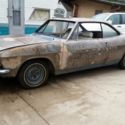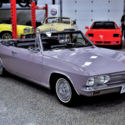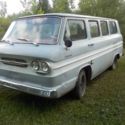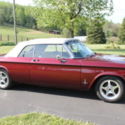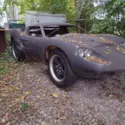1966 Chevrolet corvair convertible parts car













Vehicle Description
This car was bid on by a zero feedback bidder. As you can guess he didn't pay for it.This will be the last chance for this little car. If it goes unsold or unpaid it will be destroyed after being stripped for parts.I am guessing that this is a 1966 . This little car is in poor to fair condition for it's age. It will need to be completely disassembled, new floor panels installed, needs new rocker panels and repairs to the interior. The roof will need newvinyl cover. Engine is there and seems to have compression. It has no spark. Looking and the job someone did in installing the coil I can see why. I have $1600.00 in this right now. I need to make a little profit, Not too much. I want to see this old girl have a second chance.Just know this is not for the beginner builder.It needs lots of work on the body. Good news is it's mostly all there.Feel free to ask any question you may have. If this doesn't sell I will be tearing it down and selling the parts. and crushing the body.after it's been stripped.History of the Corvair The fantabulous Corvair was an actually innovative car unlike anything built in the era. Perhaps the short-lived,at-the-moment reviled 1948 Tucker Sedan, now a desired, massive animal made of rolling art and a pricey rarityfor collectors ( also one the most liked cars by this narrator ), was somehow an inspiration for our subject. Bothmodels had in common a rear-engined architecture propelled by an air-cooled boxer six engine, and were truly anoteworthy thing within the automotive market, like the unique central, third headlight featured on theaforementioned Tucker. Both models also received heavy criticism from the media, although the Corvair managedto roll on for a few years and make some respectable figures before such heat kicked in, mostly because it was aproduct by one of the Big Three ( suspected to pull the strings of the Tucker demise, along with some Michigansenator at the time ) and not a noble creation which produced such amount of beauty and magnificence.The first Corvairs would make their way just before the turn of one of the most mind bending decades of ourhistory, in all means. The very first model would be soon followed by the sporty Monza, a nameplate that gotmated to the Corvairs until their end of production and the announcer, and discoverer, of a new kind ofautomobile: a budget, sports car. The scarce and ignored Station Wagon gave way to another delight: the MonzaConvertible, and the first and only turbo-charged, boxer engine ever featured in the America market, truly boostingthe sports image of the Monza. The 1964 Corvairs would refine to the most the first generation, improving itsriding and quality. The arrival of the new generation in 1965 astonished everybody with a mouth-watering shape,still accompanied by the boxer six powerplants, now boosting a top of 180 horsepower on the Corsa Spydermodels, the sportiest of all sporty Corvairs.Sadly, the advent of the first muscle car, the Ford Mustang, released in April 1964, and the release of the 1965Ralph Nader’s book Unsafe at Any Speed, specifically its first chapter, dedicated to the Corvair, sentenced the car,which saw how the sales plummeted ( from more than 230,000 units of the 1965 model built, to barely more than100,000 units in 1966, and less than 30,000 units in 1967 ), never recovering and loquaciously expressing the lossof confidence given by a misguided, heavily published notion of the Corvair handling. Despite the completelyrenewed and improved suspension, which only increased a driving safety which existed since the very beginningof the production in late 1959, production lowered to a pitiful 6,000 number of its last model year. The affirmationsmade about the Corvair handling were debunked in 1972 by a safety commission from the Texas A&M University,but it was extremely late for the untimely demise of such an avant-garde car.This book will try its best to pay homage to the Corvair, and it is for all of you, for free.
